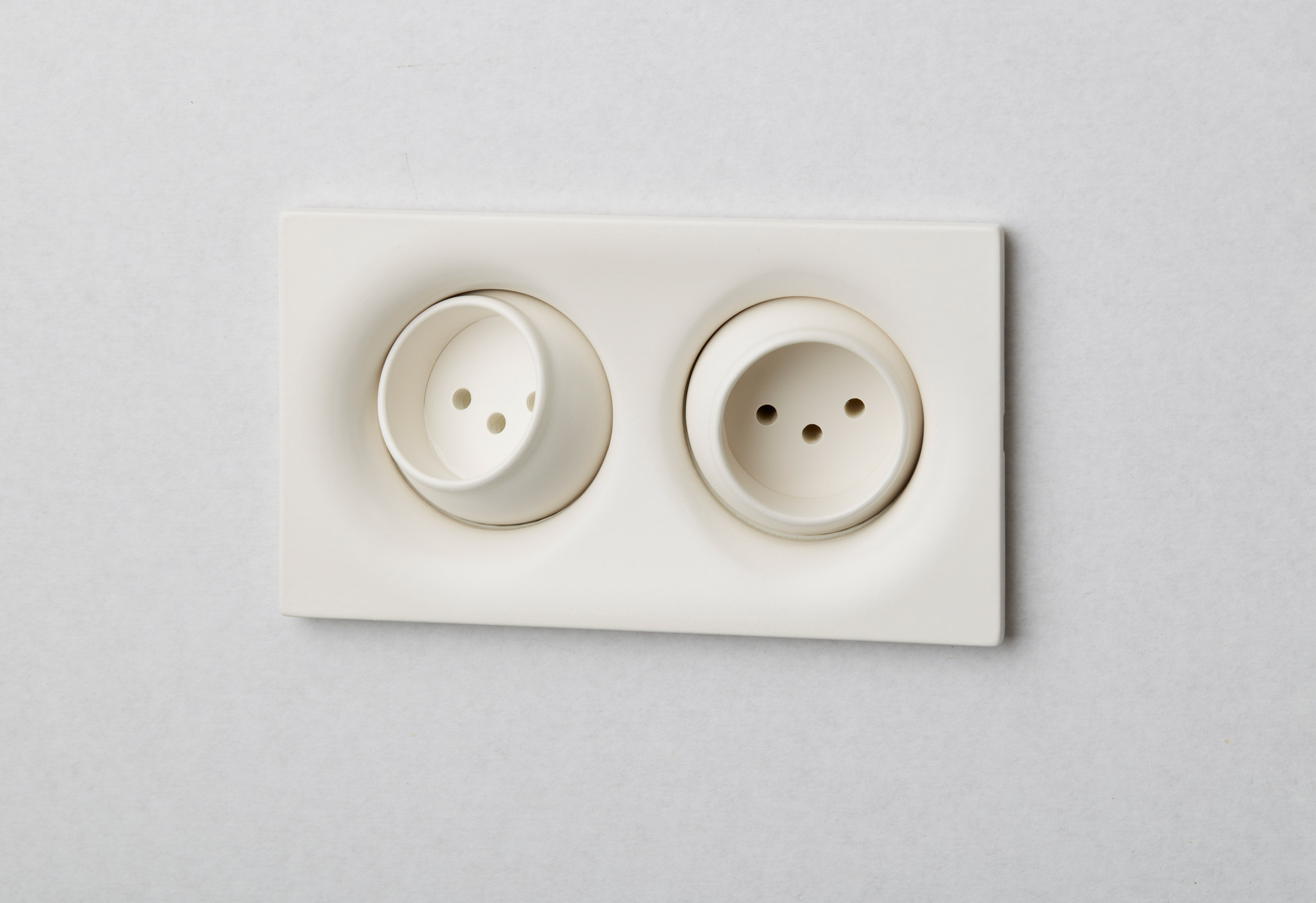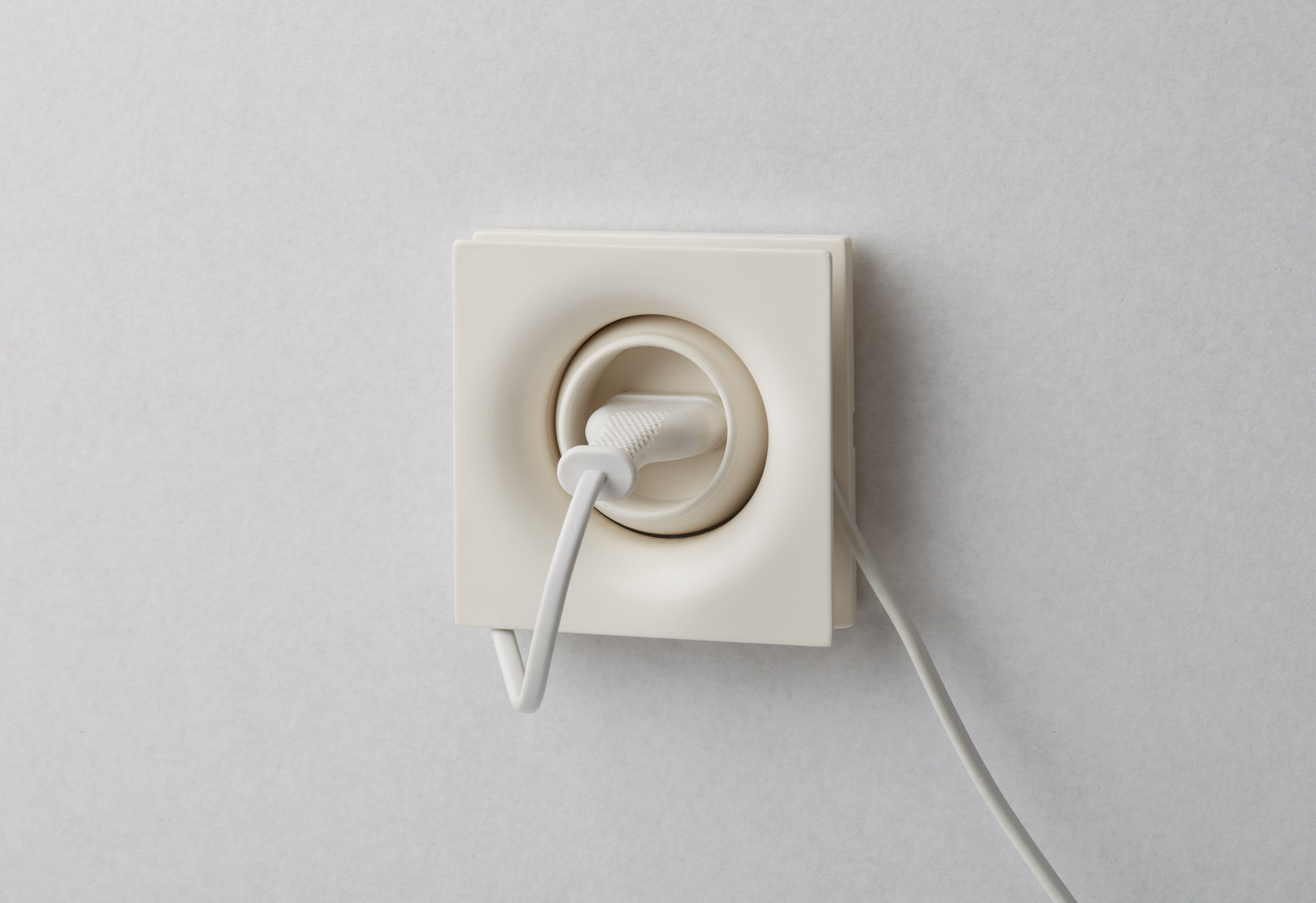Souhaïb Ghanmi uses animal bones instead of plastic for minimalist sockets and light switches


Waste bovine bones from the meat industry have been ground into a powder and turned into a collection of light switches and electrical outlets by ÉCAL graduate Souhaïb Ghanmi.
The Elos range features sinuous silhouettes modelled on different parts of the human skeleton, including a socket designed to resemble the head of a thigh bone that is capable of rotating in its baseplate like a hip joint.
 The Elos collection encompasses sockets (above), switches and USB-charging ports (top image)
The Elos collection encompasses sockets (above), switches and USB-charging ports (top image)
Matching light switches and USB charging ports are cast in moulds that reference the organic shape of a cross-sectioned femur but still resemble their conventional plastic counterparts.
By harnessing bone's natural properties as an electric and thermal insulator, the collection finds a renewed purpose for this age-old material, which was traditionally carved into tools or fired to create bone china.
 The fittings are made from bone powder mixed with a bio-based binder
The fittings are made from bone powder mixed with a bio-based binder
Ghanmi hopes that his project can help to break our reliance on fossil plastics while making a dent in the more than 130 billion kilograms of bone waste produced by slaughterhouses every year.
"This mineral material, which has no commercial value today, has been used for the manufacture of domestic objects by various peoples throughout history," he told Dezeen.
"In the past, bone was the equivalent of plastic, and nowadays plastic is one of the biggest ecological problems. It is therefore obvious to me to return to this primitive material to apply it to our daily lives."
 Phones can rest on the protruding baseplate of the USB port while charging
Phones can rest on the protruding baseplate of the USB port while charging
Ghanmi came up with the idea for the collection after staying with his father's family in rural Tunisia during the Muslim festival of Eid al-Adha, when a ritual animal is sacrificed and its meat split equally between family, friends and those in need.
The festivities allowed Ghanmi to witness first-hand the vast amount of biological waste – such as hooves, hides and tendons – that is generated in the process of slaughtering an animal.
"My uncle used to recover the bones after the festivities and make knife handles out of them," Ghanmi remembered. "Thanks to him, I became curious about this material, which before I considered as waste."
 The sockets can rotate to protect cables from wear and tear
The sockets can rotate to protect cables from wear and tear
In Canada and the US – one of the most meat-fed countries in the world – farms and slaughterhouses generate more than 31 million tons of inedible animal by-products every year.
A large part of this ends up in landfills or incinerated, releasing greenhouse gases during decomposition or combustion.
Just over half, around 16 million tons, is processed into useful products by rendering companies. Here, the bones are cleaned, dried and crushed to make fuel, fertiliser, animal feed and gelatin.
[ 
Read:
Valdís Steinarsdóttir turns animal skin and bones into food packaging
](https://www.dezeen.com/2021/01/27/valdis-steinarsdottir-food-packaging-vessels-animal-skin-bones/)
Ghanmi sourced the bone powder for his Elos collection from one of these rendering plants and mixed it with a bio-based binder.
As part of his research, the designer experimented with multiple different binder options, including bioresins and different glues made using bovine nerves and bone collagen.
"As I'm currently working on it for a possible development, I'm afraid I can't share specific details of the production," he said. "However, the aim is for the material to only use bones itself and for it to be durable and recyclable."
 The light switches are modelled on the shape of a cross-section thigh bone
The light switches are modelled on the shape of a cross-section thigh bone
After being mixed with a binder, the material is cast into the desired shape in a process not dissimilar from the one used traditionally to create switches and sockets, which are compression-moulded using urea-formaldehyde (UF).
This thermosetting plastic does not remelt when exposed to heat, making it suited to use in electronics but at the same time exceedingly difficult and uneconomical to recycle.
In a bid to offer a circular alternative to this, Ghanmi is working on optimising the durability and recyclability of his bone composite so that it can be crushed back into a powder and formed into new products.
 The protruding baseplate can also act as a cable reel
The protruding baseplate can also act as a cable reel
Certified for safety and performance, he says bone could be used to substitute plastic components in lighting and electronics, which would help to drive up the demand for animal by-products and create an increased financial incentive for keeping them out of landfills.
Alongside switching to regenerative agricultural practices and reducing meat production overall, this could ultimately help to create a more responsible way of farming livestock.
With a similar aim, Icelandic designer Valdís Steinarsdóttir has previously created vessels from animal bones and collagen that dissolve in hot water, while ceramicist Gregg Moore created tableware for a nose-to-tail restaurant in New York using waste bones from its kitchen.
The photography is byNoé Cotter.
The post Souhaïb Ghanmi uses animal bones instead of plastic for minimalist sockets and light switches appeared first on Dezeen.
#all #products #design #materials #technology #highlights #bones #écal #studentprojects #plugs #graduates

There are no comments yet.